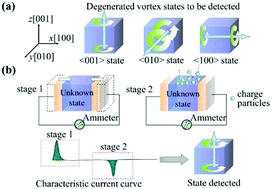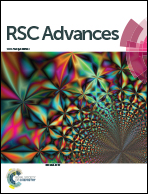Size-dependent and distinguishing degenerated vortex states in ferroelectric nanodots under controllable surface charge conditions†
Abstract
Here we propose a method to detect the degenerated tetragonal vortex states (i.e., the toroidal axis is along the x-, y- or z-axis) in ferroelectric nanodots by applying a controllable surface charge (CSC) condition. Electrodes are placed at two parallel surfaces of the nanodot to form a short circuit. Surface charges with a controllable density are then applied to another two parallel surfaces of the nanodot. Under this CSC condition, a characteristic short-circuit current vs. time (I–t) curve related with the evolution of domain structure in a nanodot can be detected. The evolution paths and the characteristic short-circuit I–t curves of the degenerated vortex states in ferroelectric nanodots have been systematically revealed by our phase field simulations by solving the time-dependent Ginzburg–Landau (TDGL) equations. It is found that the degenerated vortex states exhibit distinct evolution features under the CSC condition. In the stages of placing electrodes and increasing surface charges, one, two, and zero short-circuit I–t peak(s) are observed in the nanodots with 〈100〉, 〈010〉 and 〈001〉 vortex states, respectively. Therefore, the unknown vortex states of a nanodot can be distinguished. We further investigate the effects of temperature and nanodot size on the characteristic I–t curves of the vortex states. The results show that the vortex states can be nondestructively distinguished by applying the CSC condition if the nanodot size is within a moderate range (i.e., 8–12 nm). Our study provides an alternative way of detecting the degenerated tetragonal vortex states in ferroelectric nanodots without the use of a scanning probe microscope, and also sheds light on the application of ferroelectric vortex domain structures in novel devices such as memories, sensors and actuators.


 Please wait while we load your content...
Please wait while we load your content...